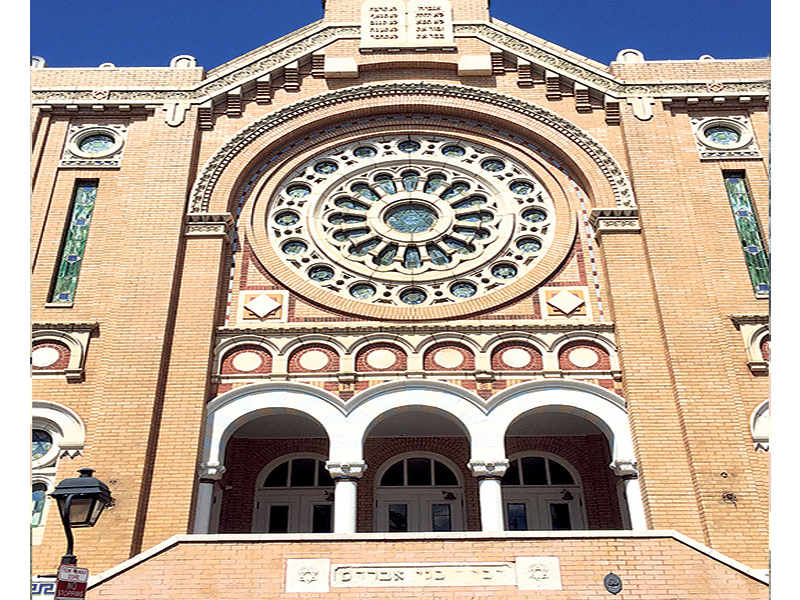When we first arrived at the National Museum of American Jewish History in Philadelphia, I overheard two older ladies chatting as they were coming out of the museum. Both were smiling broadly, and one said, “This is the first Jewish museum I’ve visited and left happy!”
Nestled within the historic Old City area of Philadelphia, the museum does what very few other Jewish museums do. It presents the story of American Jewry within a positive framework.

The museum illustrates the American Jewish experience in fantastic detail, with numerous artifacts and exhibits spread over several floors, which highlight the Jewish struggle of trying to integrate into American society, while preserving the heritage and traditions from the “Old Country.”
The American Jewish response to the Holocaust is covered in great detail, but the museum excels in depicting the American Jewish experience from early immigrants in the 17th century, through Jewish participation in the U.S. Civil War. From tenement life in overcrowded cities through eventual migration to the suburbs, the prevailing sadness that encompasses many Jewish museums is noticeably absent here.
Among the most fascinating artifacts in the museum are a model of the Touro Synagogue in Newport, R.I., along with the original letter sent by George Washington to the congregation where he wrote that the United States government would give “to bigotry no sanction, to persecution no assistance.”
Uniforms worn by Jewish soldiers on both sides during the Civil War are prominently displayed, as is a menu from the Reform Movement’s circa 1880 “Trefe Banquet” in Cincinnati, featuring many non-kosher items such as shellfish. Irving Berlin’s piano, Albert Einstein’s pipe, Steven Spielberg’s first camera and a vial of Jonas Salk’s original polio vaccine are also on exhibit.
A period of excellent weather allowed us to fully experience how incredibly walkable Philadelphia is. Within a few short blocks of the museum are the attractions that define the area as being the cradle of American Democracy. Independence Hall, the Liberty Bell and the National Constitution Center comprise several of the buildings within Independence Mall and are all within one kilometre.
The National Constitution Center houses several original engravings of the constitution, as well as one of the 12 remaining copies of the Bill of Rights. The first exhibit, which exits into the main gallery, is a 360-degree theatrical presentation called Freedom Rising. The presentation traces the quest for freedom in the United States. It’s an engaging and moving experience that sets the tone well for the rest of the museum. The main gallery follows the history of the constitution through more than 100 exhibits, many of which are hands-on.

A short walk from Independence Mall is historic Congregation Mikveh Israel. Founded by Spanish and Portuguese Jews in 1740, Mikveh Israel is among the oldest continuous synagogues in North America.
Known as “the Synagogue of the American Revolution,” the congregation was among the first to serve the burgeoning Philadelphia Jewish community. With funds provided by numerous individuals, including Benjamin Franklin and philanthropist Haym Solomon, the synagogue grew steadily through the early 19th century.
The congregation moved several times over its history, but still maintains daily services, even though the majority of Philadelphia’s Jews have moved to the suburbs. The current building was opened on the American Bicentennial, July 4, 1976. The space was shared with the Museum of American Jewish History until 2010 when the museum moved into its own building.

Although the museum moved, many of Mikveh Israel’s artifacts remained behind and are on display. A tour of the building yielded numerous impressive examples, including Torah rimmonim (crown-like adornments) crafted in 1782 by Myer Myers, a Jewish silversmith from New York, and a chair donated by Dr. Moses Lopez in 1816.
Following a stop at Betsy Ross’ house and nearby Elfreth’s Alley, the oldest continuously habited street in the U.S. that dates back to 1702 (though the oldest house was built in 1728), we decided to continue about two kilometres down to historic Congregation B’nai Abraham.
Founded in 1882 by Russian Jews fleeing persecution, B’nai Abraham served the Ashkenazi Orthodox community whose numbers had grown by that time and whose needs differed from those at the Sephardi Mikveh Israel.
The synagogue was unique in its early dedication to Zionism. At a time when the majority of Orthodox synagogues did not approve of the founding of a Jewish state until the coming of the Mashiach, B’nai Abraham’s Rabbi Bernard Levinthal actively pursued that goal and helped to establish the American Mizrachi organization in 1902.
The current building, designed in Byzantine Revival architecture, was completed in 1910. It remains the oldest building in Philadelphia to continuously function as a synagogue.







